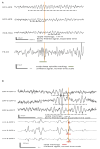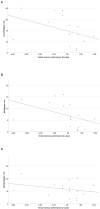Mesial-Temporal Epileptic Ripples Correlate With Verbal Memory Impairment
- PMID: 35720106
- PMCID: PMC9204013
- DOI: 10.3389/fneur.2022.876024
Mesial-Temporal Epileptic Ripples Correlate With Verbal Memory Impairment
Abstract
Rationale: High frequency oscillations (HFO; ripples = 80-200, fast ripples 200-500 Hz) are promising epileptic biomarkers in patients with epilepsy. However, especially in temporal epilepsies differentiation of epileptic and physiological HFO activity still remains a challenge. Physiological sleep-spindle-ripple formations are known to play a role in slow-wave-sleep memory consolidation. This study aimed to find out if higher rates of mesial-temporal spindle-ripples correlate with good memory performance in epilepsy patients and if surgical removal of spindle-ripple-generating brain tissue correlates with a decline in memory performance. In contrast, we hypothesized that higher rates of overall ripples or ripples associated with interictal epileptic spikes correlate with poor memory performance.
Methods: Patients with epilepsy implanted with electrodes in mesial-temporal structures, neuropsychological memory testing and subsequent epilepsy surgery were included. Ripples and epileptic spikes were automatically detected in intracranial EEG and sleep-spindles in scalp EEG. The coupling of ripples to spindles was automatically analyzed. Mesial-temporal spindle-ripple rates in the speech-dominant-hemisphere (left in all patients) were correlated with verbal memory test results, whereas ripple rates in the non-speech-dominant hemisphere were correlated with non-verbal memory test performance, using Spearman correlation).
Results: Intracranial EEG and memory test results from 25 patients could be included. All ripple rates were significantly higher in seizure onset zone channels (p < 0.001). Patients with pre-surgical verbal memory impairment had significantly higher overall ripple rates in left mesial-temporal channels than patients with intact verbal memory (Mann-Whitney-U-Test: p = 0.039). Spearman correlations showed highly significant negative correlations of the pre-surgical verbal memory performance with left mesial-temporal spike associated ripples (rs = -0.458; p = 0.007) and overall ripples (rs = -0.475; p = 0.006). All three ripple types in right-sided mesial-temporal channels did not correlate with pre-surgical nonverbal memory. No correlation for the difference between post- and pre-surgical memory and pre-surgical spindle-ripple rates was seen in patients with left-sided temporal or mesial-temporal surgery.
Discussion: This study fails to establish a clear link between memory performance and spindle ripples. This highly suggests that spindle-ripples are only a small portion of physiological ripples contributing to memory performance. More importantly, this study indicates that spindle-ripples do not necessarily compromise the predictive value of ripples in patients with temporal epilepsy. The majority of ripples were clearly linked to areas with poor memory function.
Keywords: epilepsy; high frequency oscillations (HFO); memory; ripples; sleep spindles; temporal lobe epilepsy.
Copyright © 2022 Bruder, Wagner, Lachner-Piza, Klotz, Schulze-Bonhage and Jacobs.
Conflict of interest statement
The authors declare that the research was conducted in the absence of any commercial or financial relationships that could be construed as a potential conflict of interest.
Figures




Similar articles
-
Scalp and hippocampal sleep correlates of memory function in drug-resistant temporal lobe epilepsy.Sleep. 2024 Feb 8;47(2):zsad228. doi: 10.1093/sleep/zsad228. Sleep. 2024. PMID: 37658793 Free PMC article.
-
Physiological Ripples Associated With Sleep Spindles Can Be Identified in Patients With Refractory Epilepsy Beyond Mesio-Temporal Structures.Front Neurol. 2021 Feb 10;12:612293. doi: 10.3389/fneur.2021.612293. eCollection 2021. Front Neurol. 2021. PMID: 33643198 Free PMC article.
-
Spontaneous ripples in the hippocampus correlate with epileptogenicity and not memory function in patients with refractory epilepsy.Epilepsy Behav. 2016 Sep;62:258-66. doi: 10.1016/j.yebeh.2016.05.025. Epub 2016 Aug 9. Epilepsy Behav. 2016. PMID: 27517349
-
High-frequency oscillations and mesial temporal lobe epilepsy.Neurosci Lett. 2018 Feb 22;667:66-74. doi: 10.1016/j.neulet.2017.01.047. Epub 2017 Jan 20. Neurosci Lett. 2018. PMID: 28115239 Review.
-
Exploring Ripple Waves in the Human Brain.Clin EEG Neurosci. 2023 Nov;54(6):594-600. doi: 10.1177/15500594211034371. Epub 2021 Jul 21. Clin EEG Neurosci. 2023. PMID: 34287087 Review.
Cited by
-
Scalp and hippocampal sleep correlates of memory function in drug-resistant temporal lobe epilepsy.Sleep. 2024 Feb 8;47(2):zsad228. doi: 10.1093/sleep/zsad228. Sleep. 2024. PMID: 37658793 Free PMC article.
-
The decreased connectivity in middle temporal gyrus can be used as a potential neuroimaging biomarker for left temporal lobe epilepsy.Front Psychiatry. 2022 Aug 10;13:972939. doi: 10.3389/fpsyt.2022.972939. eCollection 2022. Front Psychiatry. 2022. PMID: 36032260 Free PMC article.
References
LinkOut - more resources
Full Text Sources

